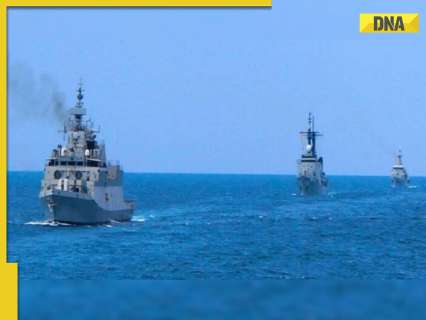
Unmanned systems not only enhance operational efficiency but also align with India’s broader goals of technological self-reliance and maritime dominance.
As India celebrates Navy Day 2024, the focus shifts to the Indian Navy’s transformation into a modern, technology-driven force. Among the most pivotal advancements in recent years is the integration of unmanned systems into naval operations. These platforms, harnessing cutting-edge technologies like artificial intelligence (AI), autonomy, and advanced sensors, are revolutionising how the Navy secures the Indian Ocean Region (IOR) and projects power across the Indo-Pacific. Unmanned systems not only enhance operational efficiency but also align with India’s broader goals of technological self-reliance and maritime dominance.
Unmanned Systems: A Strategic Necessity
The maritime domain is increasingly characterised by asymmetric threats, geopolitical tensions, and evolving challenges such as piracy, illegal fishing, and maritime terrorism. These require advanced tools that offer flexibility, precision, and resilience. Unmanned systems—comprising Unmanned Aerial Vehicles (UAVs), Unmanned Surface Vessels (USVs), and Unmanned Underwater Vehicles (UUVs)—serve as force multipliers in this context.
With their ability to operate in high-risk or contested environments, these platforms reduce the need for human involvement in dangerous missions while providing the Navy with enhanced surveillance, reconnaissance, and combat capabilities. Their versatility ensures that the Navy remains agile and responsive to evolving maritime challenges.
The Indian Navy’s Unmanned Arsenal
Unmanned Aerial Vehicles: Eyes in the Sky: The Indian Navy has been a pioneer in deploying UAVs for Intelligence, Surveillance, and Reconnaissance (ISR) missions. Israeli-origin platforms like the Heron and Searcher Mk II have been instrumental in enhancing maritime situational awareness. These UAVs are equipped with sophisticated imaging systems and sensors that provide real-time intelligence, crucial for monitoring vast maritime zones.
The Navy has also leased two MQ-9A SeaGuardian drones from the United States, significantly boosting its ISR capabilities. Covering over 14 million square miles, these UAVs deliver unparalleled intelligence and targeting data, enabling the Navy to respond swiftly to potential threats.
Looking ahead, the Navy’s Request for Information (RFI) for Naval Shipborne Unmanned Aerial Systems (NSUAS) highlights its ambition to deploy specialised drones capable of operating from warships. These platforms will play a critical role in anti-piracy missions, coastal security, and search-and-rescue operations.
Unmanned Surface Vessels: The Silent Sentinels
The introduction of USVs represents a paradigm shift in surface operations. The Matangi, an autonomous surface vessel developed indigenously, exemplifies this technological leap. Capable of travelling 1,500 km autonomously, the Matangi is designed for ISR missions and can be equipped for combat roles.
USVs like the Matangi offer strategic advantages by enabling persistent surveillance over large areas, reducing costs associated with manned missions, and operating effectively in hostile environments.
Unmanned Underwater Vehicles: Masters of the Deep
The Indian Navy is also advancing its underwater capabilities with large UUVs weighing approximately 100 tonnes. Equipped with state-of-the-art combat systems, these platforms enhance the Navy’s ability to monitor deep-sea areas, detect mines, and conduct covert operations. Their stealthy nature makes them invaluable for intelligence gathering and reconnaissance in contested waters.
Strategic Benefits of Unmanned Systems
The integration of unmanned platforms delivers several strategic advantages to the Indian Navy:
– Enhanced Maritime Domain Awareness: Unmanned systems provide comprehensive coverage of vast maritime regions, crucial for monitoring foreign naval activities and ensuring security in the IOR.
– Cost Efficiency: Compared to conventional warships and submarines, unmanned systems are cost-effective, allowing the Navy to maximise operational output within budget constraints.
– Risk Mitigation: By deploying unmanned systems for high-risk missions, the Navy reduces the potential for human casualties, preserving its skilled workforce.
– Flexibility and Versatility: Unmanned platforms can be rapidly reconfigured for diverse missions, from ISR to combat, ensuring adaptability in a dynamic operational environment.
Challenges and Opportunities
While unmanned systems offer transformative potential, their integration poses several challenges:
– Technological Dependence: Despite strides under initiatives like Aatmanirbhar Bharat, the Navy remains reliant on foreign technology for critical components such as AI algorithms, sensors, and propulsion systems. Bridging this gap through indigenous innovation is essential.
– Cybersecurity Risks: As unmanned systems rely heavily on communication networks, they are vulnerable to cyberattacks. Ensuring robust cybersecurity measures is critical to maintaining their operational integrity.
– Integration Complexity: Incorporating unmanned systems into the existing naval fleet requires advanced combat management systems capable of processing data from multiple sources and providing actionable intelligence in real time.
– Training Needs: The successful deployment of unmanned platforms necessitates a workforce skilled in operating, maintaining, and innovating these systems. Comprehensive training programmes must be prioritised.
– Infrastructure Development: Dedicated facilities for the deployment, maintenance, and storage of unmanned platforms are essential for their sustained operation.
A Vision for the Future
The Indian Navy’s focus on unmanned systems aligns with its broader goal of becoming a net security provider in the IOR and a leading maritime force in the Indo-Pacific. These platforms not only enhance operational capabilities but also underscore India’s commitment to technological innovation and self-reliance.
As the Navy continues to invest in research and development, foster public-private partnerships, and modernise its operational doctrines, unmanned systems will form the backbone of its future strategies. From aerial surveillance to underwater reconnaissance, these platforms are set to redefine the Navy’s role in safeguarding India’s maritime interests.
On this Navy Day, as we celebrate the legacy and achievements of the Indian Navy, the integration of unmanned systems serves as a testament to its vision for the future—a Navy that is not just powerful but also agile, innovative, and ready to meet the challenges of tomorrow.
The seas are changing, and the Indian Navy is charting a course towards a new era of autonomous naval power, securing its place as a global maritime leader.
(Disclaimer: The views expressed above are the author’s own and do not reflect those of DNA)
(The author of this article is a Defence, Aerospace & Political Analyst based in Bengaluru. He is also Director of ADD Engineering Components, India, Pvt. Ltd, a subsidiary of ADD Engineering GmbH, Germany. You can reach him at: girishlinganna@gmail.com)
